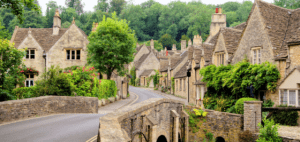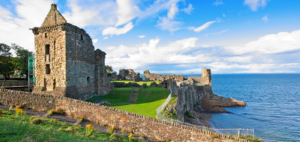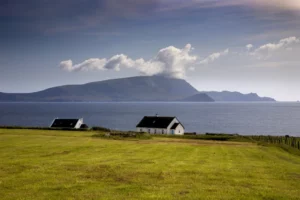Legendary Castles in Ireland: The Truth Behind the Irish Urban Legends
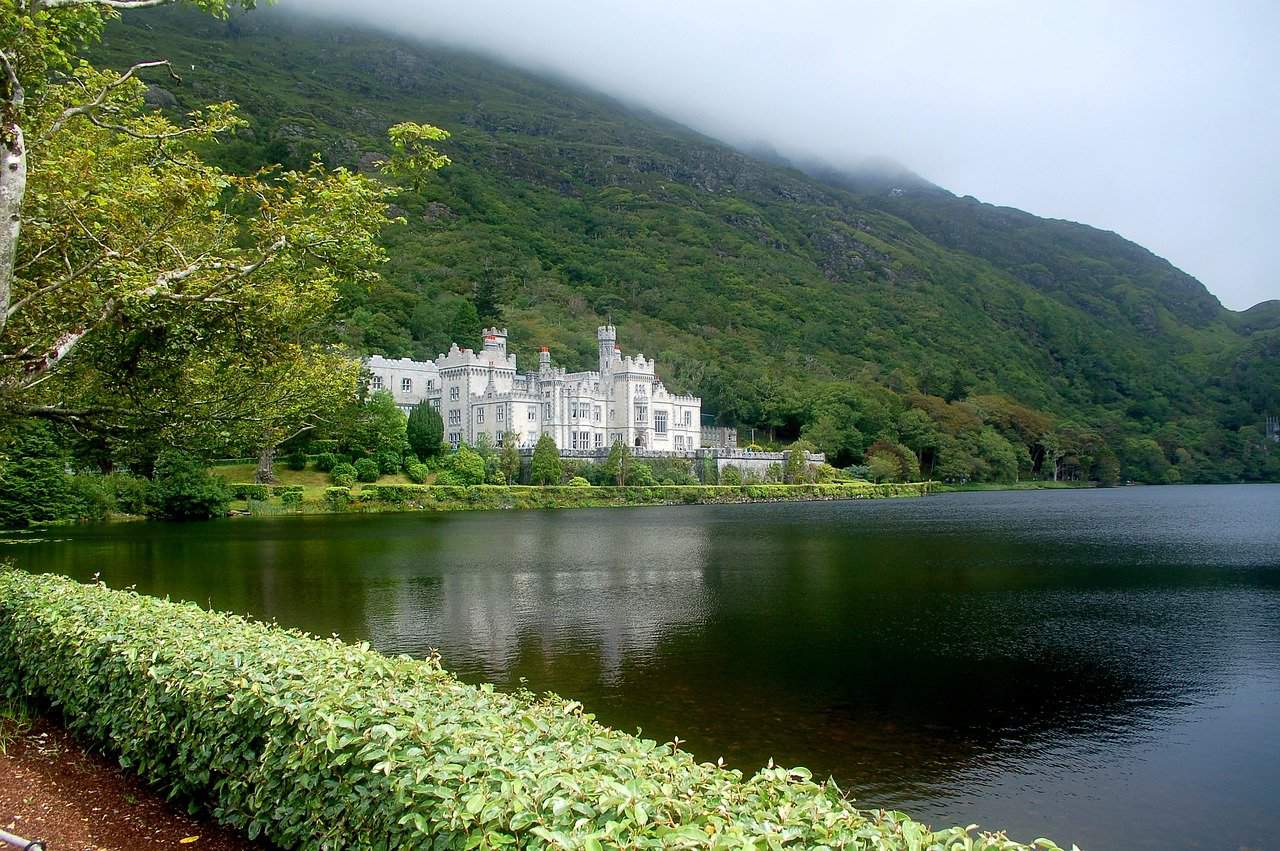
Updated On: April 21, 2024 by Dina Essawy
Every country worldwide has its fair share of myths and urban legends based on real-life events or figments of people’s imaginations to explain actual occurrences.
However, no country has such an abundance of urban legends as Ireland. A country with a rich history in its own right, Ireland is no short on myths, from faeries and goblins to ghost stories and frightening apparitions. If you ever visit this beautiful country, take the time to learn the legendary stories behind many of its castles.
We’ve assembled some of the most interesting Irish urban legends and legendary castles for you right here, so please read on ahead and let us know what you think!
Kylemore Castle
The first legendary castle featured in this article is Kylemore Castle (also known as Kylemore Abbey), founded in 1920 on the grounds of the Benedictine Monastery in Galway County, Connemara. The castle was initially designed as a private residence for the family of Henry Mitchell, a wealthy London doctor and liberal politician. The Abbey was founded for Benedictine Nuns who escaped from Belgium during WWI.
Located only an hour away from Galway, Henry poured his life’s energy into creating an estate that would showcase what could be achieved in the remote wilds of Connemara. Today, Kylemore Abbey is owned and run by the Benedictine community.
The Creation of The Castle
The construction of this residence began in 1867 with a hundred men and four years to complete the work, which cost a little over £29,000. The castle occupies approximately 40.000 square feet and consists of over seventy rooms.
Inside is a large ballroom, a billiard room, a library, a study, a gun room, 33 bedrooms and much more. After Henry Mitchell and his family returned to England, the castle was sold to the Duke and the Duchess of Manchester in 1909.
However, due to heavy gambling debts, they also had to sell the property. In 1920, the Benedictine Nuns bought the land with the Abbey, the castle and the Victorian gardens.
Unfortunately, its status as one of the legendary castles in Ireland did not prevent it from getting heavily bombed during WWI. It was rebuilt only thanks to the Benedictine community and the donations of private citizens.
History of Kylemore Castle
The nuns took possession of Kylemore Castle and estate in 1920 for £45,000. In The History of Kylemore Castle and Abbey by Kathleen Villers-Tuthill, Mother Abbess Magdalena Fitzgibbon recounts the rich history of the legendary castle, “Kylemore Abbey has been a Benedictine House for over eighty years.
The Abbey, which was once a fairy-tale Castle, was built in the 19th century by Mitchell Henry and stands today as a monument to a great gentleman and kindly landlord who spent most of his fortune on the estate and for the good of the local people…Founded in Ypres in 1662, our community was made an Irish House in 1684.
On the request of King James 11, and under the guidance of Lady Abbess Butler, the Community moved to Ireland in 1688. However, following James’s defeat at the Battle of the Boyne two years later, the Nuns returned to Ypres, where they remained for the next 224 years…Since its beginning, Kylemore has been a focal point in the West of Ireland.
Previous generations of Benedictine Nuns, for whom Kylemore served as home, have left us with a legacy of love for the place, a sense of stewardship for its continuance and a recognition of its uniqueness in location and attraction.”
Further History Surrounding the Castle
“Kylemore is an oasis of peace in a restless world, and we, as a community, are glad to share this peace with all who visit. The Benedictine life is balanced with prayer and work (Ora et Labora), and at the Abbey, we invite those who wish to do so to join us in worship.
“Mitchell Henry was a deeply spiritual person, and it can only please him to know that a Community of Benedictine now has its home in his Castle, praying the Liturgical Hours while maintaining the estate and undertaking the tremendous task of observing and restoring its many natural and important heritage features”.
Kylemore’s history is not free from tragedy, as an enormous fire took hold of the Abbey in 1959. According to Lady Abbess, Agnes, the youngest Abbess in Europe at 36, recalled the terrifying events of that fateful night, “I remember waking up about two in the morning, and I heard a cracking sound…I ran to the school dormitory, called the nun sleeping there and told her to get the girls up.
We got them out the back way, a door leading onto the mountain at the back. We would all have been burnt if that door had not been there. We had just got out at a time when the whole dormitory was up in flames.”
Castle Legends
Now comes the part about the legend. It is said that a beautiful white horse rises from the water in front of the Abbey once every seven years. In 2011, several Kylemore Abbey staff members claimed to have seen a white horse on the lake’s surface on a particularly windy day.
The strong wind raised only white foam, but the “apparition” only fueled the legend. Kylemore is, therefore, often referred to as “Pol a Capall”, which translates as ‘The Place of the Horse’.
Blarney Castle (Kiss the Blarney Stone!)
Everyone must have heard the popular idiom once or twice, but have you ever wondered where it originated? This is perhaps one of the most well-known Irish urban legends. The medieval fortress in Cork is probably one of the most famous castles, and it spawned a legend that has lasted for hundreds of years.
Creation of Blarney Castle
Although it was initially constructed in the 13th century, nothing much remains of the original fort as it was destroyed in 1446. It was rebuilt again by Cormac Laidir MacCarthy, Lord of Muscry.
Throughout history, Blarney Castle has often changed owners until it got to the Jefferyes family. The descendants of the Colthurst family, a relative to the Jefferyes through marriage, still live at Blarney House.
Legend of Blarney Stone
As for the legend that has been tied to the fort for so long, it is said that if you kiss the Blarney stone at the castle’s peak upside down, you will receive the gift of eloquence. The legend was perpetuated by many world leaders and public figures who have taken it upon themselves to take the almost impossible risk, including Winston Churchill, Mick Jagger, Laurel and Hardy,
Thankfully, the once dangerous endeavour is now slightly more safeguarded as the parapet is fitted with wrought-iron guide rails and protective crossbars. However, the climb is still not recommended for the faint of heart or those with extreme fear of heights.
The tradition originated in the 18th century, although another legend may suggest that it was in circulation over a hundred years earlier than indicated. It is said that when Queen Elizabeth I deprived Cormac Teige McCarthy, the Lord of Blarney, of his traditional land rights, Cormac, who was desperate to persuade the Queen to change her mind, met an old woman on the way who told him that anyone who kissed a particular stone in Blarney Castle would be given the gift of eloquent speech, “Cormac when Blarney Castle was built, one stone was put into place by a man who predicted no one would ever be able to touch it again.
More Legends Surrounding Blarney Stone
If you can kiss that stone, the gift of eloquence will be conferred upon you.” Cormac, who was not known as an eloquent speaker at all before that incident, went on to persuade the queen that he should not be deprived of his land. The word “blarney,” means skilful flattery or nonsense. It supposedly came into use after the incident with Queen Elizabeth.
The legend of the Blarney Stone was shared far and wide, with many believing its supernatural powers. Below is a snippet from the Washington Post on the powers bestowed upon Winston Churchill, one of the many who have braved the dangerous climb for the sake of the precious gift.
Washington Post Snippet
“Mr. Churchill is a dangerous public man,
according to all the traditions,
for the learned lexicographers state
that he who kisses the Blarney Stone
is endowed with the power ‘to blarney,’
and ‘to blarney,’ they say, is to humbug
with wheedling talk so as to gain a desired end….”
- Washington Post, 28 July 1912
Origin of Blarney Stone
There are plenty of legends surrounding the origins of the stone itself. One legend claims the Blarney Stone was Jacob’s Pillow. The prophet Jeremiah is said to have brought it to Ireland, where it became the “Lia Fáil”, meaning Stone of Destiny. This was the stone on the inauguration mound on the Hill of Tara, where the High Kings of Ireland were crowned.
Another myth claims the stone was St. Columba’s deathbed pillow. He died on the island of Iona, and after his death, the stone was moved to mainland Scotland. There, it became the Scottish Stone of Destiny.
The stone made its way back to Ireland as a gift from Robert the Bruce to Cormac MacCarthy, King of Munster and owner of Blarney Castle, as Cormac sent five thousand of his men over to Scotland to help Robert the Bruce defeat the English at Bannockburn in 1314.
Another legend that is also widely circulated claims that the stone was brought back to Ireland from the Crusades. This myth claims it is the “Stone of Ezel”, the biblical stone that David hid behind to escape Saul.
Nonetheless, most of these legends have now been discredited as, according to the Guardian, Geologists at the University of Glasgow’s Hunterian Museum have revealed the true origin of the Stone after studying a historic microscope slide. They discovered that the Blarney is a limestone geologically unique to the region where it is based.
Classiebawn Castle
Many legendary castles worldwide have their own resident ghost stories, and most of these ghost stories result from the tragic death of the person whose ghost now haunts said location. The same applies to Classiebawn Castle.
Viscount Palmerston built this Victorian mansion on an estate of about 10.000 acres on the Mullaghmore Peninsula in County Sligo. The castle was later expanded in the 19th century.
History of Classiebawn Castle
Like many other Irish castles, the castle has changed owners over the centuries. One of these owners, Edwina Mountbatten, Countess of Mount Batten of Burma, and her husband provided the building with electricity and the main water supply.
It was Lord Mountbatten’s tragic death that spawned the haunting stories surrounding the castle, as his ship was blown up by the IRA in 1979. Legend has it that his ghost is still roaming the halls of the castle, unable to find peace as a result of his violent and sudden death.
It is also interesting to note that Lord Mountbatten was practically royalty. The deceased nobleman was Queen Victoria’s grandson, the Prince of Wales’s great uncle, the last Viceroy of India, and the former Supreme Allied Commander during WWII. Queen Elizabeth alluded to the tragic incident during a royal visit she made to Ireland in 2011, as she said that the Troubles had “touched” the Royal family personally.
Kilkenny Castle
Dubbed as one of the most haunted castles in Ireland, Kilkenny Castle belongs on our list. Built in 1195 to control main roads and the Nore River, several tragic events have occurred at the castle throughout its history.
When the flood of 1763 caused John’s Bridge to collapse, 16 people lost their lives, and until now, many of the castle’s visitors insist that they have seen their ghosts trying to escape towards the castle. These ghost stories are further perpetuated by the castle’s managers and even the locals themselves, who insist that Kilkenny somehow holds the souls of all the people who died on its premises.
A Haunted Castle
In 2010, two teenagers claimed they witnessed one of these paranormal activities. While visiting the castle with their mother, they took a photo inside the castle and later noticed a strange white light that seemed unexplainable in the dark interior of the castle.
Adding even more spookiness to the castle is another regular occurrence shrouded in mystery. During the night, while the Parade Tower is locked to outside visitors, an electronic counter placed at the tower continues to count up to a hundred visitors.
It is worth mentioning that the tower formerly served as a dungeon where many have been imprisoned before passing away. Now, the starting point for the castle tour.
Dame Alice Kyteler Witch Trail
Another famous historical incident occurred at the castle, particularly at the tower’s site. It was the Dame Alice Kyteler witch trial, which is said to be the world’s earliest recorded witch trial.
After marrying for the fourth time, suspicions were raised concerning the sudden and untimely deaths of Dame Alice’s previous three husbands. The testimonies from her children further fueled the accusations against her.
Her fourth husband’s children also accused her of attempting to poison their father. Her trial took place at Kilkenny Castle in 1324. While her servant Petronella confessed to sorcery and witchcraft after being tortured and burned at the stake, it is said that Dame Alice fled to the UK, and no record has existed of her ever since.
Dame Alice’s house is now open for visitors, some of whom insisted they have seen her ghost roaming about on occasion.
Another alleged ghost that is said to reside at Kilkenny Castle is Lady Margaret Butler, who was married to Sir William Boleyn and was the paternal grandmother of Anne Boleyn, second wife of King Henry VIII of England. Since she was born at the castle, it is said that her spirit returned to her place of birth upon her death.
Shankill Castle
Initially a Butler tower house, Shankill Castle was rebuilt in 1708 as a Queen Anne house. The castle and surrounding gardens are open to visitors, and public grounds tours are regularly provided. Elizabeth purchased the castle and Geoffrey Cope in 1991 and their daughter Sybil has recounted her experience with paranormal activities while she lived there.
History of Shankill Castle
The Aylward family built Shankill Castle in the early 18th century, and their vault lies in the graveyard on the grounds. “In the 1700s, Peter Aylward’s body was placed in the vault, but his remains were stolen and never found.
The legend goes that he was never properly laid to rest, and his ghost now roams the upstairs corridor because it is never at peace”, Sybil explains.
Another well-known incident occurred in the 1990s when a Vogue photographer worked on a photo shoot at the castle, particularly in the Blue Room. However, he could not stay in the room long, explaining, “He didn’t go into the room as he didn’t want to disturb the old lady in the rocking chair.
My mother was stunned because there was no older woman. He was convinced it was a natural person and described the woman who fit my grandmother’s description. She had passed away only a few months previously and had slept in the room.”
Huntington Castle
Another one of our legendary castles, Huntington Castle, was built in 1625 and is known to have survived a tumultuous past full of invasions and rebellions. Naturally, the castle has a repertoire of paranormal activity and ghost stories. One particularly gruesome event has left its mark to this day after nine local rebels were captured by the North Cork militia in 1798 and hanged from the castle’s avenue trees.
Castle Land
The land on which the castle was built was originally the site of a 12th-century abbey. So, it is said that monk sightings have been reported on the grounds. There have also been sightings of soldiers in the attic. The Bishop of Limerick’s ghost is said to haunt one of the castle’s main rooms.
The castle’s gardens are also unsafe from roaming spirits, such as the ghost of Ailish O’Flaherty. The first wife of Lord Esmonde (who established the castle) is sometimes seen combing her long hair. And she was wailing as she mourned her husband and son, who went off to the wars and awaited their return.
Haunting of the Castle
Another tragic figure seems to haunt the castle; this time, a soldier has been heard knocking on the castle door. As the legend goes, the Cromwellian soldier lived in the 17th century and had been sent to spy on the enemy, so he disguised himself in their clothes, but sadly, upon his return, his comrades failed to recognise him and shot him dead on sight.
Leap Castle
Murder, bloodshed, and conspiracies are usually the main elements that make up medieval history, especially the histories of legendary castles. It would make for an exciting tour of the grounds in this day and age. There are different accounts of when Leap Castle was constructed, which adds to its air of mystery. However, it was most likely built in 1250 by the O’Bannon clan.
By the 16th century, the O’Carroll Clan had gained possession of the castle. But it was followed by a history of strife within the family itself. A rivalry between the O’Carroll brothers resulted in the murder of one of them at the hands of the other in what is now dubbed the “Bloody Chapel”.
More History of the Castle
The Bloody Chapel also supposedly contains a tiny chamber entered through a narrow door initially designed as a safe room for valuables. However, the O’Carrolls reportedly used the chamber as a dungeon. Where prisoners were tossed into the room to die, and their bodies were left to rot. The morbid practice was discovered in the late 19th century when cartloads of bones were found in the area.
Leap Castle gained notoriety after it moved to the ownership of Jonathan Charles Darby, whose wife, Mildred Darby, wrote Gothic novels and held séances in the castle.
Loftus Hall
Built in the 14th century, Loftus Hall is said to be one of the most famous haunted houses in Ireland. Perhaps due to a long-standing rumour that the devil himself haunts the house. As well as the ghost of the young girl who was said to have seen him.
As the story goes, Tottenham came to take care of the mansion in 1666 while the Loftus family were away on business. Anne, Charles Tottenham’s young daughter from his first marriage, accompanied them.
Another Haunted Castle
When the family welcomes an unexpected guest who arrives on a ship that docked not far from their mansion, Anne notices that the mysterious man has a cloven foot. It is said that the man suddenly escaped through the roof, Leaving behind a large hole shaped like him.
Unfortunately, the ordeal left young Anne traumatised, and it is said that the family kept her locked away in her favourite room. In other accounts, it is said that Anne was the one who chose to isolate herself. She remained in that room until she died in 1675.
Nevertheless, the story does not stop there. It is believed that the hole that the mysterious guest left behind could never be repaired appropriately. The ghost of a young woman, presumed to be Anne Tottenham, and tourists even reported catching glimpses of her in 2011 when the house was opened for visitors.
Charles Fort
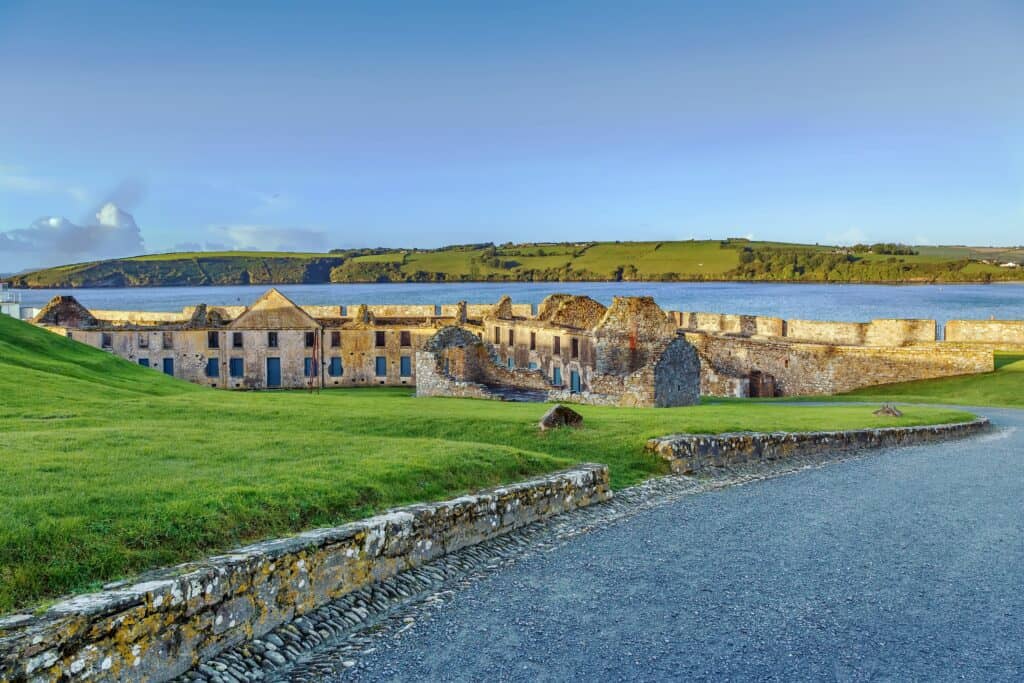
The legendary castle urban legend based in Charles Fort, Cork, has a bit of a Romeo and Juliet twist. According to the legend, the mythical castles of Charles Fort are haunted by the ghost of The White Lady. A woman is said to have killed herself after her husband was murdered on their wedding night by her father, who also committed suicide after the shock of losing his daughter.
Many, mostly children, have reported sightings of the ghost, who they say is quite friendly.
Another account of the legend states that the bride had been a local girl who married one of the foot soldiers at the Fort. They were supposed to spend their wedding night there.
However, when the soldier got drunk from the day’s celebrations, he fell asleep during his watch duty, which prompted the other soldiers to shoot him at his post, as per protocol back in the day. After hearing about her husband’s sudden death, his bride flung herself to her death from one of the Fort’s walls.
Unforgettable Irish Urban Legends Surrounding Legendary Castles
The truth behind these Irish urban legends or myths may never be uncovered, and we may be left to wonder if they are real. However, the most cynical among us may highly doubt that. Still, that does not change the fact that the history of Ireland is rife with urban legends that can scare even the most brave of us witless.
Have you ever visited any of these Legendary Castles in Ireland? We would love to hear any stories that you have.
Also, don’t forget to check out related blogs that might interest you: Kilkenny: The Splendid Reflection of the History of Ireland | Take a Look at the Astounding Scenery of County Kerry | All You Need to Know About County Laois | Diving into the Finest Legends and Tales of Irish Mythology



